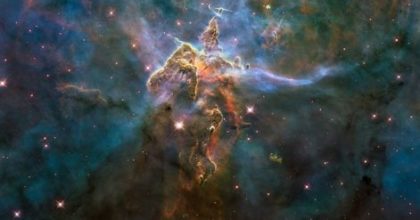
Welcome to the start of our blog book discussion of Quantum Physics and Theology by John Polkinghorne. Each week for the next 5 weeks, I’ll post some initial thoughts on a chapter to get the ball rolling, and hopefully we’ll get some discussion going in the comments. For those that like more interactive discussion, we’ll have video chats too. Based on your feedback, we’ll go on a biweekly schedule: every other Wednesday night at 9pm Eastern on Google Hangout, starting next week (9/27). The new night is in response to reported availability, plus I think having the post and the chat on the same day will make it easier to remember. Now, with the preamble out of the way, let’s get started on chapter 1!
Idiosyncracies
Actually, this quote from the preface struck me right out of the gate. On explaining why he didn’t just call the book “Quantum Theology,” Polkinghorne observes that “the strangeness encountered at different levels of reality have characters that are idiosyncratic to those levels, and no facile kind of direct transfer is possible between physics and theology.” I found myself wondering if some of my attempts at using scientific concepts for analogies would qualify as “facile.” Certainly some wariness is warranted here, since quantum physics in particular has been co-opted to justify belief in all manner of outrageous ideas to the point where the practice has a name: quantum woo. To my mind, the issue is literal application — “because of quantum entanglement, therefore telepathy” and the like. And of course trying to literally apply the behavior of billiard-ball-like particles to subatomic particles doesn’t work either, which is why we needed quantum physics in the first place. Perhaps this is what Polkinghorne means by “direct transfer” and some amount of conceptual transfer is still acceptable.
Verisimilitudinous
Polkinghorne characterizes both physics/science and theology as quests for true descriptions of reality. If I had to guess, Polkinghorne’s stated criteria for a satisfying description in either domain — “verisimilitudinous” — is probably a key point of contention for many. It’s squishy and unquantifiable where many scientists (physicists especially) expect mathematical precision. Likewise, many believers desire a more objective sense of absolute certainty than an adjective more often applied to fiction can provide. Applied the wrong way and it’s just a fancier version of truthiness. Yet for myself, I’m largely sold. Polkinghorne’s advocacy of critical realism makes a lot of sense to me and verisimilitude seems like the right companion metric. Sure, it is at least partially in the eye of the beholder, but that’s kind of the point of critical realism.
Progress
Polkinghorne makes a case for progress in scientific knowledge, a feature which in some respects distinguishes science from other intellectual pursuits including theology. I want to agree that our present scientific models are more accurate than those of 1,000 or 100 years ago. Still, all of those models once judged “verisimilitudinous” nag at me a bit. Especially troublesome are the scenarios where the scientific community debated two alternative models only for both to turn out to be equally wrong, my favorite of which is the question of whether babies started as tiny versions of themselves inside the sperm or inside the egg. In fairness, there were also those who argued that babies developed from simpler forms rather than just growing bigger. So maybe that’s the sense in which science has made progress. It’s not necessarily that we have better ideas now, but that we have narrowed down the options by ruling out an increasing number of incorrect models. That feels a bit heavy on Popperian falsification; perhaps someone can enlighten me on a better way of thinking about how science develops.
Automation
Emphasizing the human dimension of the practice of science, Polkinghorne describes it as “an activity of persons that could never be delegated simply to the working of a well-programmed computer.” I have no idea where artificial intelligence will go and whether it can make original contributions to scientific research. But I am skeptical of this kind of skepticism which relies primarily on our current inability to fully articulate how we do science and why we make certain decisions. To me, that observation says more about human limitations than those of artificial intelligence or automation.
Discussion
We still have several core elements of Polkinghorne’s thesis, including significant points of departure between science and theology and the particular similarities between the history of quantum physics and the history of Christology. I wanted to leave some space for you guys to share what intrigued or puzzled or excited you. Here’s your chance!
Andy has worn many hats in his life. He knows this is a dreadfully clichéd notion, but since it is also literally true he uses it anyway. Among his current metaphorical hats: husband of one wife, father of two teenagers, reader of science fiction and science fact, enthusiast of contemporary symphonic music, and chief science officer. Previous metaphorical hats include: comp bio postdoc, molecular biology grad student, InterVarsity chapter president (that one came with a literal hat), music store clerk, house painter, and mosquito trapper. Among his more unique literal hats: British bobby, captain’s hats (of varying levels of authenticity) of several specific vessels, a deerstalker from 221B Baker St, and a railroad engineer’s cap. His monthly Science in Review is drawn from his weekly Science Corner posts — Wednesdays, 8am (Eastern) on the Emerging Scholars Network Blog. His book Faith across the Multiverse is available from Hendrickson.

Leave a Reply